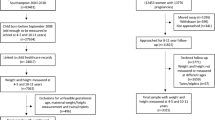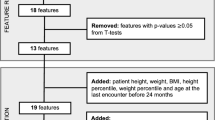Abstract
Overweight and obesity are an increasing phenomenon worldwide. Reliable and accurate prediction of future overweight or obesity early in the childhood could enable effective interventions by experts. While a lot of research has been done using explanatory modeling methods, capability of machine learning, and predictive modeling, in particular, remain mainly unexplored. In predictive modeling, the models are validated with previously unseen examples, giving a more accurate estimate of their performance and generalization ability in real-life scenarios. Our objective was to find and review existing overweight or obesity research from the perspectives of childhood data and predictive modeling. Thirteen research articles and three review articles were identified as relevant for this review. In general, prediction models with high performance either have a short time span to predict and/or are based on late childhood data. Logistic regression is currently the most often used method in forming the prediction models, although recently more complex models have also been applied. In addition to child’s own weight and height information, maternal weight status and body mass index were often used as predictors in the models. More recent research has started to focus on a wider variety of other predictors as well.
Access this chapter
Tax calculation will be finalised at checkout
Purchases are for personal use only
Similar content being viewed by others
References
Adnan MHBM, Husain W, Damanhoori F (2010) A survey on utilization of data mining for childhood obesity prediction. In: 8th Asia-Pacific symposium on information and telecommunication technologies (Kuching, 2010). IEEE, pp 1–6
Alpaydin E (2014) Introduction to machine learning, 3rd edn. MIT Press, Cambridge
Bishop C (2006) Pattern recognition and machine learning. Springer, Berlin
Breiman L (2001) Statistical modeling: the two cultures. Stat Sci 16(3):199–215. https://doi.org/10.1214/ss/1009213726
Butler ÉM, Derraik JGB, Taylor RW, Cutfield WS (2018) Childhood obesity: how long should we wait to predict weight? J Pediatr Endocrinol Metab 31(5):497–501. https://doi.org/10.1515/jpem-2018-0110
Bzdok D, Altman N, Krzywinski M (2018) Statistics versus machine learning. Nat Methods 15(4):233–234. https://doi.org/10.1038/nmeth.4642
Cheung YB, Machin D, Karlberg J, Khoo KS (2004) A longitudinal study of pediatric body mass index values predicted health in middle age. J Clin Epidemiol 57(12):1316–1322. https://doi.org/10.1016/j.jclinepi.2004.04.010
Choi E, Schuetz A, Stewart WF, Sun J (2017) Using recurrent neural network models for early detection of heart failure onset. J Am Med Inform Assoc 24(2):361–370. https://doi.org/10.1093/jamia/ocw112
Cole TJ, Lobstein T (2012) Extended international (IOTF) body mass index cut-offs for thinness, overweight and obesity. Pediatr Obes 7(4):284–294. https://doi.org/10.1111/j.2047-6310.2012.00064.x
Cole TJ, Freeman JV, Preece MA (1995) Body mass index reference curves for the UK, 1990. Arch Dis Child 73(1):25–29. https://doi.org/10.1136/adc.73.1.25
Cole TJ, Bellizzi MC, Flegal KM, Dietz WH (2000) Establishing a standard definition for child overweight and obesity worldwide: international survey. BMJ 320(7244):1240–1243. https://doi.org/10.1136/bmj.320.7244.1240
de Onis M, Onyango AW, Borghi E, Siyam A, Nishida C, Siekmann J (2007) Development of a WHO growth reference for school-aged children and adolescents. Bull World Health Organ 85(9):660–667. https://doi.org/10.1590/S0042-96862007000900010
Druet C, Stettler N, Sharp S, Simmons RK, Cooper C, Davey Smith G, Ekelund U, Lévy-Marchal C, Järvelin M-R, Kuh D, Ong KK (2012) Prediction of childhood obesity by infancy weight gain: an individual-level meta-analysis. Paediatr Perinat Epidemiol 26(1): 19–26. https://doi.org/10.1111/j.1365-3016.2011.01213.x
Dugan TM, Mukhopadhyay S, Carroll A, Downs S (2015) Machine learning techniques for prediction of early childhood obesity. Appl Clin Inform 6(3):506–520. https://doi.org/10.4338/ACI-2015-03-RA-0036
GBD (2017) Health effects of overweight and obesity in 195 countries over 25 years. N Engl J Med 377(1):13–27. (Written by GBD 2015 Obesity Collaborators). https://doi.org/10.1056/NEJMoa1614362
Graversen L, Sørensen TIA, Gerds TA, Petersen L, Sovio U, Kaakinen M, Sandbaek A, Laitinen J, Taanila A, Pouta A, Järvelin M-R, Obel C (2015) Prediction of adolescent and adult adiposity outcomes from early life anthropometrics. Obesity 23(1):162–169. https://doi.org/10.1002/oby.20921
Gupta M, Phan T-LT, Bunnell T, Beheshti R (2020) Obesity prediction with EHR data: a deep learning approach with interpretable elements. arXiv:1912.02655v5
Hammond R, Athanasiadou R, Curado S, Aphinyanaphongs Y, Abrams C, Messito MJ, Gross R, Katzow M, Jay M, Razavian N, Elbel B (2019) Predicting childhood obesity using electronic health records and publicly available data. PLoS One 14(4). https://doi.org/10.1371/journal.pone.0215571
Hochreiter S, Schmidhuber J (1997) Long short-term memory. Neural Comput. 9(8):1735–1780. https://doi.org/10.1162/neco.1997.9.8.1735
Levine RS, Dahly DL, Rudolf MCJ (2012) Identifying infants at risk of becoming obese: can we and should we? Public Health 126(2):123–128. https://doi.org/10.1016/j.puhe.2011.10.008
Lynch BA, Rutten LJF, Ebbert JO, Kumar S, Yawn BP, Jacobson D, Sauver JS (2017) Development of distinct body mass index trajectories among children before age 5 years: a population-based study. J Prim Care Community Health 8(4):278–284. https://doi.org/10.1177/2150131917704326
Morandi A, Meyre D, Lobbens S, Kleinman K, Kaakinen M, Rifas-Shiman SL, Vatin V, Gaget S, Pouta A, Hartikainen A-L, Laitinen J, Ruokonen A, Das S, Khan AA, Elliott P, Maffeis C, Gillman MW, Järvelin M-R, Froguel P (2012) Estimation of newborn risk for child or adolescent obesity: lessons from longitudinal birth cohorts. PLoS One 7(11). https://doi.org/10.1371/journal.pone.0049919
Ojala M, Garriga GC (2010) Permutation tests for studying classifier performance. J Mach Learn Res 11:1833–1863
Pang X, Forrest CB, Lê-Scherban F, Masino AJ (2019) Understanding early childhood obesity via interpretation of machine learning model predictions. In: 2019 18th IEEE international conference on machine learning and applications (ICMLA) (Boca Raton, FL, 2019). IEEE, pp 1438–1443. https://doi.org/10.1109/ICMLA.2019.00235
Redsell SA, Weng S, Swift JA, Nathan D, Glazebrook C (2016) Validation, optimal threshold determination, and clinical utility of the infant risk of overweight checklist for early prevention of child overweight. Child Obes 12(3):202–209. https://doi.org/10.1089/chi.2015.0246
Saari A, Sankilampi U, Hannila M-L, Kiviniemi V, Kesseli K, Dunkel L (2011) New Finnish growth references for children and adolescents aged 0 to 20 years: Length/height-for-age, weight-for-length/height, and body mass index-for-age. Ann Med 43(3):235–248. https://doi.org/10.3109/07853890.2010.515603
Saijo Y, Ito Y, Yoshioka E, Sato Y, Minatoya M, Araki A, Miyashita C, Kishi R (2019) Identifying a risk score for childhood obesity based on predictors identified in pregnant women and 1-year-old infants: an analysis of the data of the Hokkaido study on environment and children’s health. Clin Pediatr Endocrinol 28(3):81–89. https://doi.org/10.1297/cpe.28.81
Sainani KL (2014) Explanatory versus predictive modeling. PM R 6(9):841–844. https://doi.org/10.1016/j.pmrj.2014.08.941
Santorelli G, Petherick ES, Wright J, Wilson B, Samiei H, Cameron N, Johnson W (2013) Developing prediction equations and a mobile phone application to identify infants at risk of obesity. PLoS One 8(8). https://doi.org/10.1371/journal.pone.0071183
Shmueli G (2010) To explain or to predict? Stat Sci 25(3):289–310. https://doi.org/10.1214/10-STS330
Simmonds M, Burch J, Llewellyn A, Griffiths C, Yang H, Owen C, Duffy S, Woolacott N (2015) The use of measures of obesity in childhood for predicting obesity and the development of obesity-related diseases in adulthood: a systematic review and meta-analysis. Health Technol Assess 19(43):1–336. https://doi.org/10.3310/hta19430
Singh B, Tawfik H (2020) Machine learning approach for the early prediction of the risk of overweight and obesity in young people. In: 20th international conference on computational science – ICCS 2020 (Amsterdam, 2020), Proceedings, Part IV. Springer, pp 523–535
Weng SF, Redsell SA, Nathan D, Swift JA, Yang M, Glazebrook C (2013) Estimating overweight risk in childhood from predictors during infancy. Pediatrics 132(2):e414–e421. https://doi.org/10.1542/peds.2012-3858
Zhang S, Tjortjis C, Zeng X, Qiao H, Buchan I, Keane J (2009) Comparing data mining methods with logistic regression in childhood obesity prediction. Inf Syst Front 11(4):449–460. https://doi.org/10.1007/s10796-009-9157-0
Acknowledgements
We thank Richard Allmendinger for his comments on the initial draft article. Ilkka Rautiainen received funding from Business Finland in addition to a grant from the Jenny and Antti Wihuri Fund. Sami Äyrämö also received funding from Business Finland. The funding sources did not have any other involvement in the study.
Author information
Authors and Affiliations
Corresponding author
Editor information
Editors and Affiliations
Rights and permissions
Copyright information
© 2022 Springer Nature Switzerland AG
About this chapter
Cite this chapter
Rautiainen, I., Äyrämö, S. (2022). Predicting Overweight and Obesity in Later Life from Childhood Data: A Review of Predictive Modeling Approaches. In: Tuovinen, T., Periaux, J., Neittaanmäki, P. (eds) Computational Sciences and Artificial Intelligence in Industry. Intelligent Systems, Control and Automation: Science and Engineering, vol 76. Springer, Cham. https://doi.org/10.1007/978-3-030-70787-3_14
Download citation
DOI: https://doi.org/10.1007/978-3-030-70787-3_14
Published:
Publisher Name: Springer, Cham
Print ISBN: 978-3-030-70786-6
Online ISBN: 978-3-030-70787-3
eBook Packages: Intelligent Technologies and RoboticsIntelligent Technologies and Robotics (R0)




